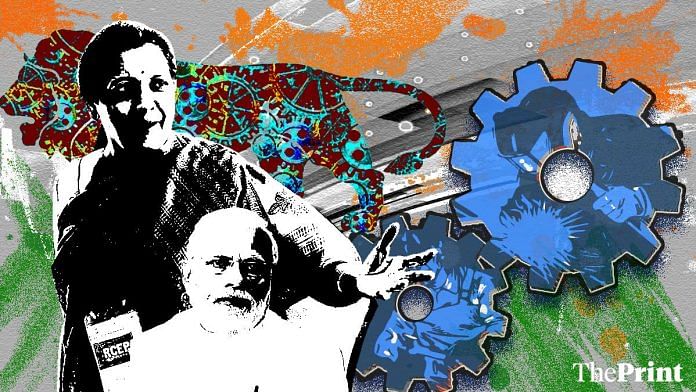On 31 May, Prime Minister Narendra Modi gave his 65th Mann ki Baat address and spoke of a self-reliant India — Atmanirbhar Bharat, while discussing the need to disincentivise import of goods, which can be manufactured domestically. Home Minister Amit Shah later argued that “India’s 130 crore population is our strength and if they decide not to buy foreign goods, India’s economy will see a jump.” The government has assiduously tried to distance itself from perceptions of protectionism, emphasizing that the objective of the Atmanirbhar Bharat Abhiyan is to enhance exports. But one can already see the presence of import-substitution policies in the government’s post-Covid-19 stimulus package, specifically in the MSME and defence sectors.
This brings us to the question — can such an import-substitution policy deliver economic growth for India? Or is this mere rhetoric intended to obtain electoral dividends?
Case of Taiwan and China
While market economists are divided on import-substitution policies, the success of the East Asian economies, particularly Taiwan and China, presents a viable case for the strategic use of Import-Substitution Industrialisation (ISI) policies, but only when applied alongside Export-oriented Industrialisation (EOI).
Due to its dexterous use of ISI and EOI policies, Taiwan and China recorded exponential economic growth from the 1960s to 1970s, and the 1980s to 1990s, respectively. In Taiwan’s case, the shift from an ISI-only policy in the 1950s to a combined ISI and EOI policy took place between 1960s to the 1980s. Taiwan selectively opened up its market in the 1960s, and in the following years, between 1966 and 1970, its GDP increased at a rate of 9.8 per cent compared to a growth rate of 6.7 per cent between 1956-60. Furthermore, its share of exports in GDP, rose from 10 per cent to 55 per cent. During this time, Taiwan also pursued a “secondary ISI policy” that targeted intermediate and capital goods, and focussed on supporting the growth of chemical and heavy industries. It successfully leveraged the use of tariffs — some often exceeding 100 per cent — on imported goods in order to give protection to its import-substituted industry.
Taiwan’s self-reliance policy for chemical and heavy industries benefited its target industries, including, the petrochemicals, steel and iron products, and capital machinery, which became “significantly self-sufficient” — the replacement of imported intermediates and capital goods by domestic substitutes contributed more than 10 per cent to their growth. Similarly, the chemicals industry also built capacity and reduced the country’s dependence on imports. As a result of this dual policy, between 1960-1973, Taiwan’s export earnings grew by 28.7 per cent. Simultaneously, the heavy and chemical industries recorded its highest growth rate of any period between 1950 and 1985.
Similarly, China, under the rule of Deng Xiaoping, shifted from an ISI-only policy in the 1950s to a dual track policy of EOI and ISI in the 1980s. In this second phase, the Chinese government — akin to Taiwan in the 1960s — prioritised growth of heavy industry and military armament through its 10 Year Plan. China implemented an ISI policy in the heavy industry sector, which included energy, iron and steel, machinery and chemical industries. With an average tariff rate of 43 per cent, China maintained high tariff barriers, compelling domestic firms to switch to products of import-substituting industries.
Simultaneously, China also selectively liberalised its markets in 1979 , mainly for primary raw materials rather than intermediate/finished goods. This allowed its domestic industries reciprocal access to foreign markets, and resulted in its share of exports rising from an average of 5.7 per cent in the 1980s to 12.4 per cent in the 1990s. China’s GDP was growing at a rate of 15.1 per cent in 1984, as compared to -1.5 per cent in 1976. At the same time, in the years between 1982 and 1984, heavy industry grew at 12.1 per cent, as compared to its 1.5 per cent growth rate in 1979-81 which was a direct result of China’s ISI policy.
Also read: Why Modi’s economic nationalism is a wrong turn for Covid-hit India
A dual track approach
The logic behind adopting a ‘dual track’ policy is primarily to increase foreign exchange. Foreign exchange — generated through exports — helps to pay for imported technology and equipment required to build capacity in import-substituting industries. Taiwan and China both promoted exports as a means of supplementing their ISI policies. In the absence of such export promotion, a horizontal ISI-only policy can negatively affect growth — as was seen in 1950s China — by suppressing consumption, thus disincentivizing people to work in the long-run, and making the country more reliant on imports. Furthermore, an ISI-only model can lead to an industrial system that is poorly competitive in the international market, and can result in high-cost producers that do not benefit domestic consumers.
Therefore, India needs to maximize its export capacity, and aggressively boost export-driven industries. The government will then be able to use foreign capital generated from these exports for upskilling, technological upgradation and capacity building in sectors covered under its ISI policy. However, this requires a prior identification of specific sectors that will benefit from such an ISI policy. Inferring from China and Taiwan’s case, the production of intermediate and finished goods in heavy industries should be prioritised. India had comprehensive import-substitution policies in place between 1947 and 1990 as well. But, in the absence of the strategic identification of sectors for implementing the ISI policy and a concomitant fillip to exports, they proved to be disastrous. If they are successful this time, India must learn from its own past and its peers. Only a limited and targeted import-substitution policy combined with aggressive export promotion can make Atmanirbhar Bharat a $5-trillion economy
Ameya Pratap Singh is a PhD Student at the University of Oxford. Urvi Tembey is an International Trade Lawyer. Views are personal.
Also read: Covid pushed women back decades. India can’t be ‘atmanirbhar’ without bailing them out







we ant to register with ministry of industry and commerce for import substitution,